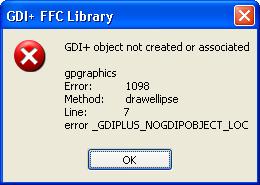
GDI+ classes help. I got this error on my app.
How do I remedy this problem so that I could continue and finish this on time?

GDI+ FFC Library
GDI + object not created or associated
Gpgraphics
Error: 1098
Method: drawellipse
Line: 7
Error_GDIPLUS_NOGDIPOBJECT_LOC
Regards,
Dennis.
GDI+ FFC Library: GDI+ object not created or associated

When you want to draw a rectangle or an ellipse, I recommend you to make use of double buffering: this is done by creating a memory DC, you can make drawing on it, and then you do BitBit on real DC. To create ellipse you can use functions, the functions are CreateEllipticRgn, CreateEllipticRgnIndirect. For your information, the function creates a region object and the region object actually made by the union of rectangles with no vertical overlap.
The regions made is basically coming from non rectangular primitives and later it try to create the ellipse by simulating and creating using multiples of rectangles, connecting the lines roughly using scanlines that used to draw the primitive. This process leads to an elliptical area that's actually made from lot of short rectangles (height of the ellipse is more than the rectangles), this can lead to lots of work and make it really slow to calculate region and clipping.
GDI (Graphics device interface) uses all of them without the need to transform it. GDI will decipher all of the coordinates for each clip region, relative to the upper corner of the window when the applicable objects of the region available to be altered with CombineRgn and OffsetRgnfunctions.
GDI+ FFC Library: GDI+ object not created or associated

If you are trying to use some library function then you need to access this library function form the library so first specify the library and then access its function.
Smith Thompson














